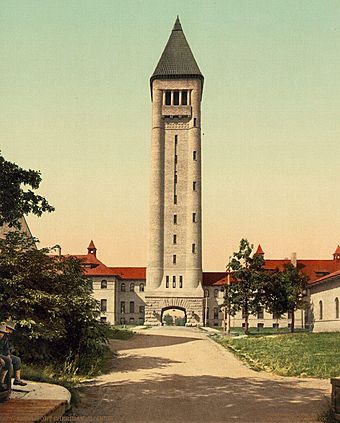Sheridan Reserve Center facts for kids
|
Fort Sheridan Historic District
|
|

Fort Sheridan water tower and barracks complex
|
|
| Location | Fort Sheridan, Illinois |
|---|---|
| Built | 1889 |
| Architect | Holabird & Roche; Office of the Quartermaster General |
| NRHP reference No. | 80001379 |
Quick facts for kids Significant dates |
|
| Added to NRHP | September 29, 1980 |
| Designated NHL | April 20, 1984 |
The Philip H. Sheridan Reserve Center is a historic place in Illinois. It used to be a big United States Army base called Fort Sheridan. This fort was named after Philip Sheridan, a famous general from the American Civil War.
Today, Fort Sheridan is located across three towns: Lake Forest, Highwood, and Highland Park. The Army officially closed most of the fort in 1993. Much of the land was sold and turned into homes. Some buildings were given to groups like Midwest Young Artists, a large youth music program. The Army still uses about 90 acres (36 hectares) of the original land as the Sheridan Reserve Center.
In 2018, Fort Sheridan was chosen as one of the "Illinois 200 Great Places." This was part of a celebration for Illinois's 200th birthday.
Contents
History of Fort Sheridan
Early Days and Purpose
In 1877, a group in Chicago called the Commercial Club wanted a military base nearby. They were worried about public safety. After a big event called the Haymarket Riot in 1886, they decided to act. The club donated 632 acres (2.6 square kilometers) of land to the United States government.
Soldiers arrived in November 1887. The base was first called Camp Highwood. A year later, it was renamed Fort Sheridan. In 1894, soldiers from Fort Sheridan helped stop problems during the Pullman Strike. This was a major railroad workers' strike.
In 1888, a designer named Ossian Cole Simonds planned the fort's layout. He included a large parade ground for military drills. He used natural ravines to frame the open space. The plan also featured a scenic drive and brick homes for officers. People thought the design was very beautiful and charming.
Wars and Training
Fort Sheridan became a key training center during wars. It helped prepare soldiers for the Spanish–American War in 1898. After World War I, almost 20,000 wounded soldiers came to Fort Sheridan. They received training to help them return to civilian life.
During World War II, over 500,000 men and women passed through the fort. Many famous army officers lived there, including George S. Patton and Jonathan Wainwright. From 1953 to 1973, Fort Sheridan supported Project Nike. This project involved antimissile systems in the Midwest. After that, it focused on administrative support for the Army.
A Historic Place
The Historic District at Fort Sheridan has 94 buildings. These were built between 1889 and 1910. Sixty-four of these buildings were designed by the famous firm Holabird & Roche. The earliest buildings were made from bricks created right on site. Clay for the bricks came from the nearby lake bluffs.
The water tower was once the tallest structure in the Chicago area. It was shortened by 60 feet (18 meters) in 1940. The buildings next to the tower were barracks where soldiers lived.
The Historic District covers 110 acres (45 hectares). It was added to the National Register of Historic Places in 1980. In 1984, it was named a National Historic Landmark. This means it is a very important historical site. In 1979, parts of the fort were used to film the movie Ordinary People.
Fort Sheridan closed in 1993. This decision was made in 1989 as part of a plan to close military bases. Today, the Army Reserve still uses about 90 acres (36 hectares). The rest of the land is now a forest preserve, homes, Navy housing, and other businesses.
Protecting the Environment
Fort Sheridan is located on a high bluff overlooking Lake Michigan. The area has deep ravines that cut into the bluff. Over many years, the Army filled some of these ravines with waste from military operations. One area, called Landfill 7, contained more toxic waste.
The United States Environmental Protection Agency (EPA) considers Landfill 7 a "Superfund" site. This means it needs special cleanup because of hazardous waste. The landfills were not managed in a way that protected the environment. For example, they did not have a special liner to stop waste from leaking.
Cleanup efforts began in 1979. The Army later tried to cover Landfill 7 with a clay cap. But this cap failed because of water problems. By 1989, the Army started looking for a permanent solution. Landfill 7 was leaking about 14,000 gallons (53,000 liters) of contaminated water into Lake Michigan every day. Lake Michigan is a source of drinking water for the area.
The Army decided to build a new, stronger cap for the landfill. This cap was finished in 2004. The goal is to contain the waste and protect the lake. The Army continues to work on cleaning up the site. Millions of dollars have been spent to make the area safe for everyone.




